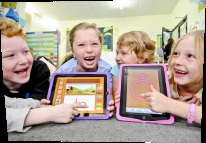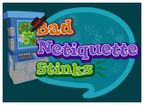K-2 Appropriate Technology Uses (DC.1)

describe appropriate and inappropriate uses of technology (e.g., computers, internet, e-mail, cell phones) and describe consequences of inappropriate uses

I can describe good uses of technology.
I can describe bad uses of technology.
I know what will happen if I use the computers in a bad way.
I can describe bad uses of technology.
I know what will happen if I use the computers in a bad way.

1. Video 0:39 What is 1 new thing you have learned on the internet?
2. 1:18 Let's go far away to the San Diego Zoo!
3. 1: 49 Who do you know that you would like to talk to on the internet? What kinds of things would you talk about?
4. 2:03 In this computer lab at Kid's Choice time, what kind of games should we choose to play?
5. 2:47 Why should you always ask your parents first before you use the computer?
6. 2:51 Why should you only talk to people you know on the internet?
7. 2:56 What does it mean to 'Stick to places that are just right for you'?
2. 1:18 Let's go far away to the San Diego Zoo!
3. 1: 49 Who do you know that you would like to talk to on the internet? What kinds of things would you talk about?
4. 2:03 In this computer lab at Kid's Choice time, what kind of games should we choose to play?
5. 2:47 Why should you always ask your parents first before you use the computer?
6. 2:51 Why should you only talk to people you know on the internet?
7. 2:56 What does it mean to 'Stick to places that are just right for you'?

Bad Netiquette Stinks
Clicky and his friends race to stop Potty-Mouth Pete from spreading bad netiquette.
Stop for partner discussions at 1:09,
What do you think 'Bad Netiquette' means? Give 3 different examples to your partner.
2:35, Examples of 'Bad Netiquette' in the video were:
1. Being mean online
2. Bad behavior online
3. Losing your online manners
4. Calling other kids bad names
5. Ruining games for other players
What do you think the 'Good Netiquette' means?
4:20, Predict what you think is going to happen next! Give 2 examples each.
6:13 What are some good examples of online netiquette? Give 3 different examples to your partner.
Examples of 'Good Netiquette in the video were:
1. Being nice online
2. Being respectful online
3. Good online manners
Clicky and his friends race to stop Potty-Mouth Pete from spreading bad netiquette.
Stop for partner discussions at 1:09,
What do you think 'Bad Netiquette' means? Give 3 different examples to your partner.
2:35, Examples of 'Bad Netiquette' in the video were:
1. Being mean online
2. Bad behavior online
3. Losing your online manners
4. Calling other kids bad names
5. Ruining games for other players
What do you think the 'Good Netiquette' means?
4:20, Predict what you think is going to happen next! Give 2 examples each.
6:13 What are some good examples of online netiquette? Give 3 different examples to your partner.
Examples of 'Good Netiquette in the video were:
1. Being nice online
2. Being respectful online
3. Good online manners
